First Page | Previous Page | Return To Index | Next Page | Last Page
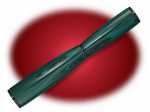
|
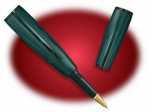
|
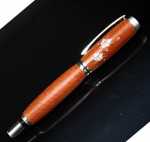
|
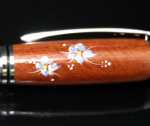
|
| Urushi finished Panache (CS USA) in blue ebonite--or so they tell me. I'm color blind, particularly in the blue-green and red-orange color ranges. |
Urushi is applied with a slightly rounded stick, typically made of birch. A small amount of urushi is applied to the stick and then the stick is used much like an artist's palette knife to apply and spread the urushi.
Urushi cures through a combination of heat and humidity.
The lacquered blanks are set into a specially-built humidor to cure. The curing process takes aapproximately 1 week per coat. The surface is then polished with charcoal made from birch wood.
The preceding steps are repeated as many times as is necessary to achieve the depth and lustre desired. In some cases this is as few as seven layers while other cases may require a dozen or more layers. This particular pen has 8 layers of finish. |
This Baron, in kwila, is my first successful attempt at hand-painting pens. I have been studying painting for about 3 months now and am improving (somewhat) despite my color-blindness. Janet Smith (from the IAP) has been my cheerleader and therapist through the process. |
The flowers are abstracts based on South Pacific flowers found in a Google Images search. Most of my technique starts with Donna Dewberry's One-stroke techniques. These are acrylic paint over a lacquer finish with a CA topcoat to protect the painting. |
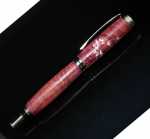
|
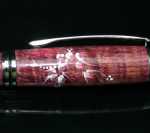
|

|

|
| Second success with this technique. My next step is to attempt to incorporate the painting with my urushi finishing method. |
These flowers are likely to be more representative of what I will use when I attempt a maki-e pen as they are much more Asian-themed. |
Ebonite, long a favorite of fountain pen collectors, is a hard rubber product which has remarkable durability. The beautiful coloring is a product of a unique process by a German company who releases small quantities on a highly irregular schedule. |
Dichroic glass is a glass containing multiple micro-layers of metal oxides, with a total thickness of three to five millionths of an inch, which gives the glass dichroic optical properties.
NASA developed dichroic glass for use in satellite mirrors. Multiple ultra-thin layers of different metal oxides (gold, silver, titanium, chromium, aluminium, zirconium, magnesium, silicon) are evaporated on to the surface of the glass in a vacuum chamber. Based on which oxide is used, certain wavelengths of light will either pass through or be reflected, causing an array of colors to be visible.
|

|

|

|

|
| Beautiful native North American woods have been professionally dyed in the vibrant, traditional colors (dark blue, light blue, red and yellow) of the symbolic autism puzzle and stabilized for years of worry-free use. A black puzzle piece is inserted representing the missing piece to the puzzle. The puzzle itself is made up of 20 separate pieces which are hand-set in the cylindrical shape, then glued in place and meticulously finished. A true one of a kind.
A portion of the proceeds from the sale of these pens will be donated to various charities involved in solving the “puzzle” of autism.
|
Gossamer wisps of a black vaporous silk that is trapped in a transparent ruby matrix. These are the only words to describe this pen! Prystal, a variation on the original bakelite, is so hard to obtain you may never see another!
|
Celebrating man's adventure into the dark unknown, the barrels of this pen showcase rocketry, the moon, stars and comets in custom poured resins and woods.
This design was created by my dear friend, Jeff Powell.
|
Through autumn's golden gown we used to kick our way
You always loved this time of year.
Those fallen leaves lie undisturbed now
'Cause you're not here
A gentle rain falls softly on my weary eyes
As if to hide a lonely tear...
My life will be forever autumn
'Cause you're not here
with thanks to Jeff Wayne and Justin Hayward
Original design by my dear friend, Jeff Powell.
|

|

|

|

|
| Beautiful California buckeye burl has been professionally dyed in 18 vibrant colors and stabilized for years of worry-free use. The puzzle itself is made up of 36 pieces, no two of which are alike. Each is hand-set in the cylindrical shape, then glue in place and meticulously finished. |
|
Arabesque art consists of a series of repeating geometric forms which are occasionally accompanied by calligraphy. Ettinghausen et al. describe the arabesque as a "vegetal design consisting of full...and half palmettes [as] an unending continuous pattern...in which each leaf grows out of the tip of another." To the adherents of Islam, the Arabesque are symbolic of their united faith and the way in which traditional Islamic cultures view the world. The plant forms represents the feminine nature of life giving.
|
Unique shapes and distinct colors. Paramecia? Amoebae? Plankton? No, this is a beautiful collection of twigs, cast in a luxurious resin, which were storm blown this past spring. |